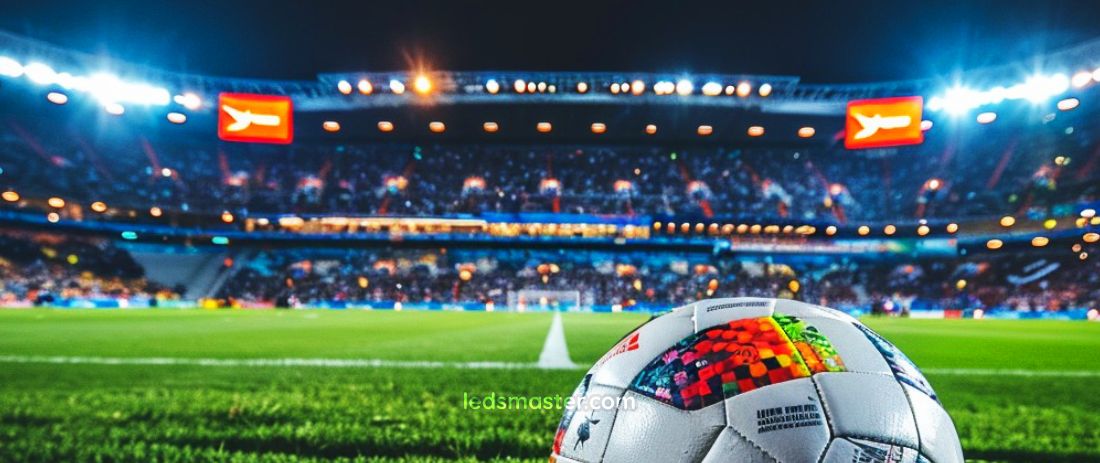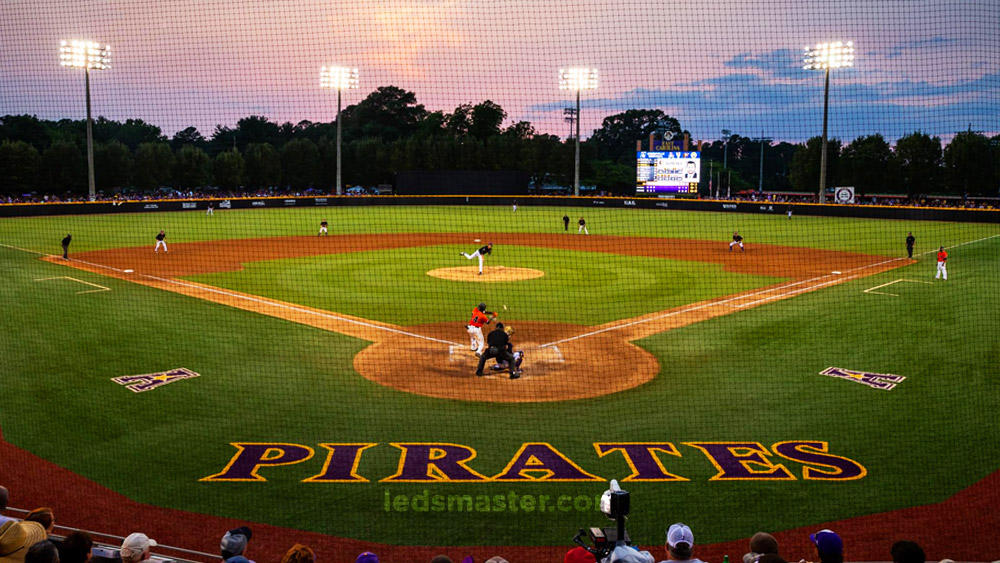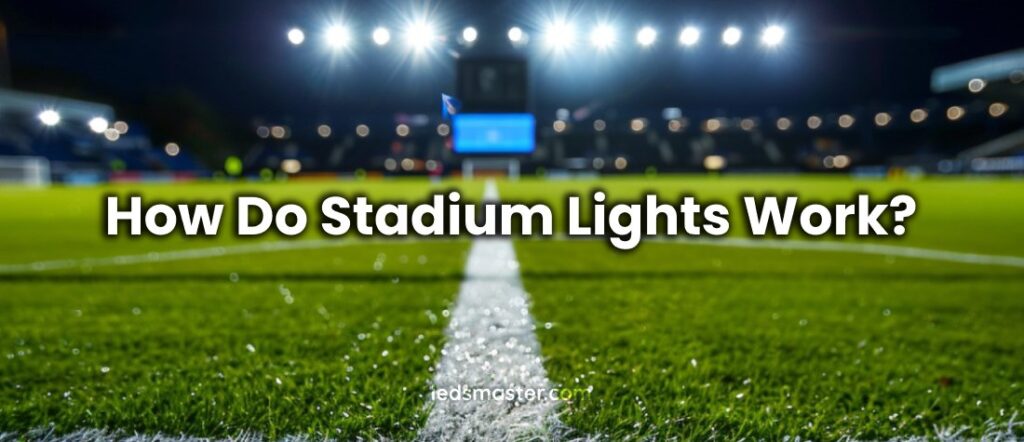As a buyer of stadium lighting, understanding how these lights operate and selecting the right ones for your needs can be complex. In this article, we will delve into the working principles of stadium lights and explore the key factors to consider when choosing the best lighting solutions, such as beam angle, lumens, and placement.
Table of Contents
ToggleHow Do Stadium Lights Work?
Stadium lights, including floodlights and spotlights, are essential for providing intense, direct illumination to large sports fields and spectator areas. These powerful lighting systems are designed to focus a strong beam of light on specific areas, such as a football field, soccer pitch, baseball stadium, or cricket ground. Properly controlling the brightness is crucial, as overly intense light can cause discomfort and visual strain for athletes and spectators alike.
Light Intensity and Beam Angle
The core principle of effective stadium lighting hinges on achieving adequate illumination through the precise application of lumens and the appropriate selection of beam angles. Lumens, a measure of the total amount of visible light emitted by a light source, are critical for determining the brightness needed to ensure comprehensive coverage of the stadium. Higher lumen outputs result in brighter lighting, which is essential for illuminating large sports arenas where visibility needs to be maintained consistently across vast areas. The correct beam angle, which determines how light is distributed over the field, plays a crucial role in ensuring that the light reaches the necessary areas without causing excessive glare or leaving dark spots. By carefully calibrating both lumens and beam angles, stadium lighting systems can provide optimal visibility for players and spectators, enhancing the overall experience and ensuring that the lighting meets the specific demands of the event.
Floodlights vs. Spotlights

In the context of stadium lighting, floodlights and spotlights serve distinct but complementary roles. Floodlights are characterized by their broad beam angles, which typically range from 30 to 90 degrees. This wide dispersion makes them ideal for covering large sections of the playing field and surrounding spectator areas. Floodlights are essential for creating an even, shadow-free lighting environment, which helps to reduce visual fatigue and improve the overall visibility for players, officials, and fans. They provide a blanket of light that ensures uniform illumination, making them indispensable for sports like soccer or football, where the entire field needs to be consistently lit.
Conversely, spotlights feature narrower beam angles, often between 10 and 30 degrees. These lights are used to focus intense beams of light on specific areas, such as the center of a field, a goal area, or a particular spot where critical game action occurs. The concentrated light provided by spotlights is crucial for creating dramatic effects and enhancing visibility in key action zones, such as in baseball where the batter’s box or pitcher’s mound requires focused illumination. The precision of spotlights allows for detailed lighting control, highlighting important areas without unnecessarily illuminating the entire field, thus adding a strategic element to the lighting setup.
Installation and Configuration
The effectiveness of stadium lighting is significantly influenced by the installation and configuration of the lighting system. Stadium lights are typically mounted on tall poles or structures strategically placed around the perimeter of the field. The height, layout, and orientation of these poles are critical factors that determine how well the light covers the field and the seating areas. Higher poles can cast light over greater distances, making them suitable for large stadiums where uniform coverage is essential. The configuration of the lights, including the angle and power settings, must be carefully chosen to achieve the desired illumination pattern. For example, a smaller beam angle provides a more concentrated light that can illuminate distant parts of the stadium effectively, while wider angles are useful for covering larger, closer areas. By optimizing the placement and configuration of the lights, it is possible to achieve comprehensive illumination that enhances visibility and reduces shadows, ensuring a well-lit environment for both players and spectators.
Balancing Brightness
Achieving the right balance of brightness is crucial in stadium lighting design to prevent glare and ensure comfortable visibility. Excessive brightness can cause glare, which not only hampers the visual performance of athletes but also affects the viewing experience of spectators. Glare can lead to visual discomfort and reduce the overall quality of the lighting environment. Therefore, the lighting design must carefully consider both the intensity and distribution of light. This involves ensuring that the lighting is bright enough to illuminate the entire stadium effectively, without being overpowering. By balancing the brightness, lighting systems can provide clear, comfortable visibility that supports optimal performance and enhances the spectator experience. The goal is to create a well-lit environment that facilitates clear visibility while avoiding excessive light that could detract from the quality of the experience.
Choosing the Best Stadium Lights
When selecting stadium lights, it is essential to take into account a comprehensive set of factors that ensure the lighting system meets the specific needs of the stadium and its events. These factors include the type of sport, the stadium’s size and structure, environmental conditions, and energy efficiency. Each of these considerations plays a critical role in the effectiveness and performance of the lighting system, impacting visibility, energy consumption, and the overall experience for players, spectators, and broadcasters.
Type of Sport
Different sports necessitate distinct lighting configurations due to their unique gameplay and viewing requirements. For instance, soccer fields typically require broad and uniform illumination to cover the expansive playing area and facilitate visibility of fast-moving action across the entire field. This broad coverage helps to minimize shadows and ensure consistent lighting for both players and spectators. In contrast, baseball fields benefit from more focused lighting, particularly on areas like the pitcher’s mound, the bases, and the outfield. The action in baseball is often concentrated in specific zones, such as during a pitch or a hit, necessitating targeted lighting to enhance visibility of these critical areas. Therefore, understanding the nature of the sport being played is essential to determine the appropriate lighting design, ensuring optimal visibility and enhancing the overall experience for players and fans alike.
Stadium Size and Structure
The dimensions and architectural features of a stadium play a pivotal role in selecting the appropriate beam angles and the height and placement of light poles. Larger stadiums with expansive playing fields and tall stands require lighting systems capable of casting powerful beams over considerable distances, ensuring that light reaches every corner without significant drop-off in intensity. Conversely, smaller or uniquely shaped stadiums might require more tailored solutions, such as varying pole heights or different combinations of beam angles, to accommodate specific architectural nuances and ensure comprehensive coverage. Additionally, the presence of obstructions, such as overhead canopies or complex seating arrangements, can influence how lights are positioned and directed to avoid shadows and dark spots, creating a well-lit environment that enhances visibility and reduces glare.
Environmental Conditions
Environmental factors, including weather and ambient light conditions, significantly influence the choice and placement of stadium lights. In regions prone to heavy rain, fog, or high humidity, lights need to be robust enough to penetrate adverse conditions and provide clear visibility. Similarly, stadiums located in areas with significant ambient light, such as urban settings with nearby streetlights and buildings, must account for potential light pollution and ensure that the stadium lighting system effectively counters external lighting sources without causing excessive glare. Furthermore, considerations such as wind speed and direction might impact the stability and durability of lighting fixtures, necessitating the use of resilient materials and secure mounting solutions to maintain consistent performance despite varying environmental challenges.
Energy Efficiency
Choosing energy-efficient lighting solutions, such as LED lights, offers several advantages for stadiums, including higher energy efficiency, longer lifespan, and better control over brightness and color temperature. LED lights consume less power compared to traditional lighting technologies while providing equal or greater brightness, leading to significant cost savings in terms of electricity consumption. Additionally, the longer lifespan of LEDs reduces the frequency of replacements and maintenance, contributing to lower operational costs and increased reliability. The ability to control brightness and color temperature with precision allows stadium operators to adjust lighting conditions dynamically, enhancing the viewing experience and accommodating different events or time-of-day requirements. By opting for LED lighting, stadiums not only achieve superior performance and sustainability but also align with modern standards for energy efficiency and environmental responsibility.
Glare Reduction in Stadium Lighting

Effective glare reduction is a critical consideration in stadium lighting design. Glare occurs when bright light sources or poorly controlled light beams interfere with visibility, creating visual discomfort for athletes and reducing the quality of life for nearby residents due to light pollution. If stadium lights are not equipped with high-quality optics, they can scatter light indiscriminately, resulting in intense glare that impairs athletes’ performance and disturbs people living near the stadium. This light leakage can lead to complaints from the community and may even necessitate regulatory action to mitigate its impact.
To address glare issues, modern stadium lighting systems, such as those offered by LedsMaster, incorporate advanced technologies like patented secondary optical designs. These innovations are engineered to precisely control and focus the light beam on designated areas, significantly reducing unwanted light spill. LedsMaster’s LED stadium lights, for instance, can suppress up to 80% of glare through precise beam angle control and accurate aiming. This technology not only improves the quality of illumination by enhancing light uniformity but also reduces light loss as the beam travels through the stadium. This precise control ensures that the light is effectively directed where it is needed, enhancing visibility on the field while minimizing adverse effects on surrounding areas. By employing such advanced optical technologies, stadium lighting systems can provide optimal illumination for events while maintaining a comfortable environment for athletes and local residents.
HID vs. LED Stadium Lights
Traditionally, High-Intensity Discharge (HID) lamps, including mercury vapor and metal halide lamps, were the primary choice for stadium lighting due to their high lumen output. HID lamps are capable of producing the high lux levels required to illuminate large areas like football fields or soccer pitches. However, their use comes with significant drawbacks. The wattage required for HID lamps to meet the necessary illumination standards is substantially higher than that of other outdoor floodlights, often exceeding 100,000 watts for a full stadium setup. This high energy consumption translates into elevated operational costs, both in terms of electricity usage and maintenance.
Moreover, HID lamps are less energy-efficient compared to modern alternatives. They require a warm-up period of 10 to 20 minutes to reach full brightness, which can be inconvenient for events that demand instant lighting. Additionally, HID lamps have a shorter lifespan and lower efficiency, meaning more frequent replacements and higher overall costs.
In contrast, LED stadium lights offer numerous advantages over traditional HID lighting systems. LEDs are far more energy-efficient, consuming significantly less power while delivering the same, if not higher, levels of brightness. This efficiency translates into substantial cost savings in terms of energy consumption and maintenance. LEDs also provide immediate illumination without the need for a warm-up period, making them more convenient for dynamic lighting needs. The lifespan of LED lights is much longer than that of HID lamps, reducing the frequency of replacements and further lowering maintenance costs.
LED technology also allows for better control over brightness and color temperature, enabling precise adjustments to match the specific requirements of different events and settings. This flexibility, combined with superior energy efficiency and longer lifespan, makes LED lights a more sustainable and cost-effective choice for modern stadium lighting. As stadiums increasingly adopt LED lighting systems, they benefit from enhanced performance, reduced operational costs, and improved environmental sustainability, aligning with contemporary standards for energy efficiency and visual quality.
Conclusion
Selecting the right stadium lighting involves understanding how lights function and addressing key factors like beam angle, lumens, and placement. Floodlights and spotlights each serve distinct roles, with floodlights providing broad coverage and spotlights offering focused illumination. Effective installation and configuration are essential for achieving uniform lighting and preventing glare. Considering the type of sport, stadium size, environmental conditions, and energy efficiency is crucial for optimal lighting performance. Modern LED lights offer superior energy efficiency and control compared to traditional HID lamps, making them the preferred choice for stadiums.

